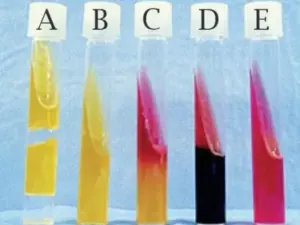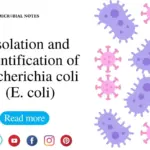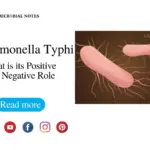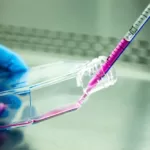Introduction
The Indole test was first introduced by Nirenberg and Mattei in 1958. Since then, it has become a widely used test in microbiology laboratories for bacterial identification. The test is simple, rapid, and reliable and can provide valuable information about the metabolic capabilities of bacteria. The Indole test is part of a group of tests called the IMViC tests, which also include the tests for methyl red, Voges-Proskauer, and citrate utilization.
Principle
The indole test is a biochemical test used in microbiology to detect the ability of an organism to produce indole. Indole is a metabolic byproduct of tryptophan, an amino acid found in proteins. The enzyme tryptophanase catalyzes the production of indole by an organism.
The principle of the indole test is based on the ability of tryptophanase to hydrolyze tryptophan to pyruvic acid, ammonia, and indole. The indole produced is then detected by the addition of a chemical reagent, usually Kovacs’ reagent or DMACA (p-Dimethylaminocinnamaldehyde), which reacts with indole to produce a pink or red color.
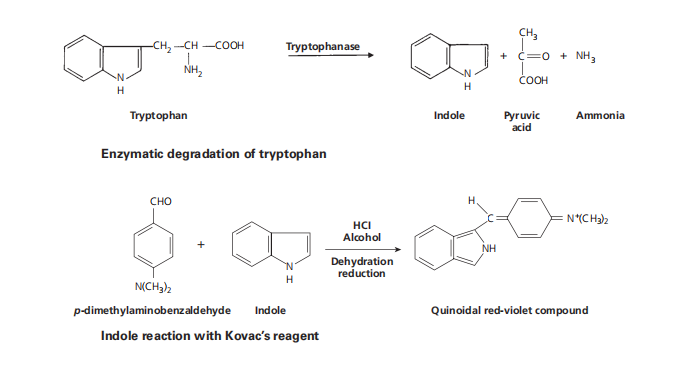
The test can be performed using two methods: the spot test and the tube test. In the spot test, a small amount of bacterial culture is placed on a filter paper or a slide, and a few drops of the indole reagent are added. In the tube test, the bacterial culture is inoculated into a tryptone broth containing a high concentration of tryptophan, and the tube is incubated. After incubation, a few drops of the indole reagent are added to the tube, and the presence of a pink or red color indicates a positive result for indole production.
.
Materials Required
- Tryptone broth – a nutrient-rich liquid medium containing tryptophan.
- Bacterial culture – the bacteria to be tested must be grown in tryptone broth or other suitable culture media.
- Kovac’s reagent – a reagent used to detect the presence of indole. It contains p-dimethylamino benzaldehyde, hydrochloric acid, and amyl alcohol.
- Sterile inoculating loop or needle – used to inoculate the bacterial culture into the tryptone broth.
- Incubator – used to grow the bacterial culture at the appropriate temperature.
Preparation of the Indole reagent:
- Kovac’s reagent is prepared by mixing the following chemicals in the order listed: 5 ml of amyl alcohol, 0.5 ml of p-dimethylaminobenzaldehyde, and 3 ml of concentrated hydrochloric acid.
- The reagent is then mixed thoroughly by shaking and allowed to stand for a few minutes before use.
Procedure
The Indole test is performed using two methods: the spot test and the tube test. Both methods are based on the ability of bacteria to produce indole by hydrolyzing tryptophan.
Spot Test Procedure
- A small inoculum of the bacterial culture is taken and streaked onto a filter paper or a glass slide.
- The Indole reagent is prepared by mixing 0.5 ml of p-dimethylaminocinnamaldehyde (DMACA) with 4.5 ml of hydrochloric acid (HCl). Alternatively, Kovacs Indole Reagent can be used as a substitute for the spot test reagent.
- A few drops of the Indole reagent are added onto the inoculated area of the filter paper or glass slide. The reagent reacts with the indole produced by the bacteria to produce a Blue-Green color.
Tube Test Procedure:
- A loopful of the bacterial culture is inoculated into a tryptone broth and incubated at 35-37°C for 24-48 hours.
- After incubation, a few drops of the Indole reagent are added to the tryptone broth.
Results and Interpretation
Spot test results
The test is considered positive if the inoculated area turns blue-green color. within 10-20 seconds of adding the reagent. A negative result is indicated by the absence of color change.
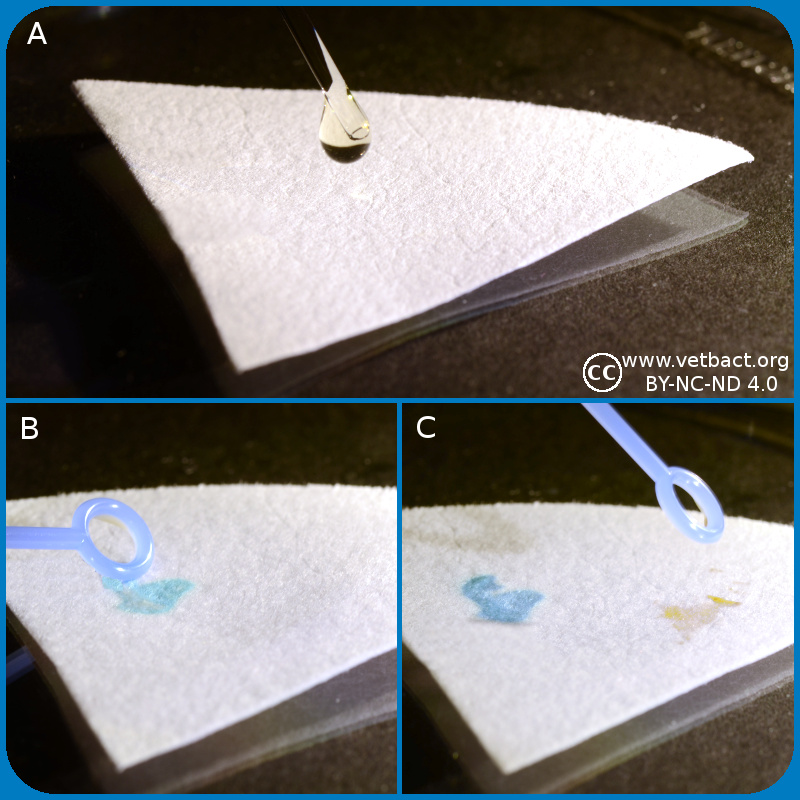
Tube results
The test is considered positive if a red-pink color develops at the top of the broth within 5-10 seconds of adding the reagent. A negative result is indicated by the absence of color change.
The tube test is considered more sensitive than the spot test for detecting the presence of indole in bacterial cultures. However, the spot test is more convenient and less time-consuming than the tube test. Both tests should be used in conjunction with other biochemical tests to ensure the accurate identification of bacterial species.

Examples of bacterial species and their Indole test results:
Escherichia coli: E. coli is a common gram-negative bacteria found in the intestines of humans and animals. It is indole-positive, and a red ring will form at the top of the tryptone broth after adding Kovac’s reagent.
Proteus mirabilis: P. mirabilis is a gram-negative bacteria found in soil and water. It is also indole-positive, and a red ring will form at the top of the tryptone broth after adding Kovac’s reagent.
Salmonella enterica: S. enterica is a gram-negative bacteria that can cause foodborne illness. It is indole-negative, and no color change will be observed after the addition of Kovac’s reagent.
Klebsiella pneumoniae: K. pneumoniae is a gram-negative bacteria found in the human respiratory and gastrointestinal tracts. It is also indole-negative, and no color change will be observed after the addition of Kovac’s reagent.
Limitations of the Indole test
- The interpretation of the Indole test results may vary depending on the incubation time and temperature and the reagents’ quality.
- The Indole test is a useful tool for identifying and differentiating between gram-positive and gram-negative bacteria, but it should not be solely relied upon for complete identification. It should be used in conjunction with other biochemical tests to ensure accurate identification of the bacterial species.
- Kovacs Indole Reagent should not be used for anaerobic bacteria, and media selected for indole determination should be tested for their suitability with known positive and negative organisms.
- Media containing glucose and dye, such as MacConkey and EMB, should not be used for indole testing due to the possibility of interference with indole color interpretation. Mueller Hinton Agar is also not recommended for this test as tryptophan is destroyed during acid hydrolysis of casein.
- When performing the Indole test, it is important to avoid false positives due to the diffusion of indole into the media. To achieve this, colonies of different morphologies that are separated by at least 5mm should be selected for indole testing
Importance of the Indole test
The Indole test is an important tool in the identification of bacteria, particularly in the differentiation of gram-negative bacteria. It is a rapid and inexpensive test that can be used in clinical microbiology laboratories to identify bacterial species and aid in the diagnosis of infections. The Indole test is often used in conjunction with other tests, such as the urease test, the citrate test, and the oxidase test, to provide a more comprehensive profile of the bacteria being tested.
Conclusion and future directions:
In conclusion, the Indole test is a valuable tool in the identification and diagnosis of bacterial infections. It has limitations, but when used in conjunction with other tests, it can provide a reliable profile of the bacteria being tested. In the future, advances in technology may lead to the development of more sensitive and specific tests for the detection of indole and other compounds, which could further improve the accuracy of bacterial identification and diagnosis.
Frequently Asked Questions
What is the purpose of the indole test?
The indole test is used to detect the presence of indole-producing bacteria, which can aid in the identification and differentiation of bacterial species.
What reagent is used for the indole test?
Kovacs’ reagent or DMACA (p-Dimethylaminocinnamaldehyde) can be used to detect indole production in the test.
What types of bacteria can be identified using the indole test?
Bacteria that produce indole, such as some members of the Enterobacteriaceae family, including Escherichia coli, Proteus spp., and Klebsiella spp., can be identified using the indole test.
What is the procedure for the indole test?
The test can be performed using two methods: the spot test and the tube test. In the spot test, a small amount of bacterial culture is placed on a filter paper or a slide, and a few drops of the indole reagent are added. In the tube test, the bacterial culture is inoculated into a tryptone broth containing a high concentration of tryptophan, and the tube is incubated. After incubation, a few drops of the indole reagent are added to the tube.
References
- https://asm.org/Protocols/Indole-Test-Protocol
- Cappuccino J.G. and Sherman N. 2008. Microbiology: A Laboratory Manual, 8th ed. Pearson Benjamin Cummings, San Francisco, CA, USA.
- https://www.vetbact.org/popup/popup.php?id=35&LANG=en
- https://microbiologie-clinique.com/indole-test-en.html



